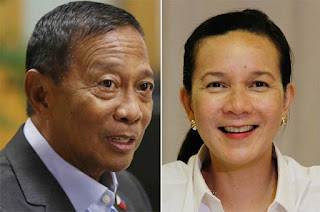1. “Inclusive” means you, the candidate, is committed to
the quality of life of, by, and for the whole Filipino people. Inclusive development means enabling the poor, the
vulnerable, the marginalized, and the disadvantaged to develop faster than the
rest of society.
2. “Principled” comes from a consistent code of behavior
(“sa isip, sa salita, at sa gawa”) that, faced with a series of dilemmas,
enables you to choose the higher interest of nation over sectarian or narrow
interests.
3. “Competent” comes from doing the right things right –
good technical and administrative results being consistently produced to match
good intentions. This includes extending your reach beyond your grasp through
teamwork and technology.
4. “Humility” is when self-praise is unnecessary; it
comes from public acknowledgment that you are inclusive, principled, and
competent.
I commented and gave a direct answer, No.
But in fairness to Mar Roxas, other Presidentiables like VP Jojjo Binay, former President Erap Estrada, Sen. Alan Cayetano, Sen. Bongbong Marcos, other presidentiables, will also have a NO answer, at least
for me.
Sen. Grace Poe may have humility; and competence, am not sure.
With the current system of personality-oriented, not
philosophy or ideology-oriented politics in the PH, no candidate can be really
principled. Where the populist and welfarist idea prevails, Presidentiables and other politicians will be swayed by populism
too. If majority of voters want more subsidies, more welfare, more entitlement programs, never mind that taxes
are high and public debt is rising yearly because of annual deficit, with or without a crisis, most or
all Presidentiables will be swayed towards populism.
Being a free marketer and believer of classical liberalism
(not US liberalism or other variants), the closest political party in this ideology
in the PH is the Liberal Party. The LP is also affiliated with Liberal International (LI),
based in Europe. European liberalism is closer to classical liberalism.
My beef or complain about the LP is that it is not acting liberal
enough. Many of Its policies adopted and implemented is far from being liberal
but closer to the populist and welfarist philosophy. Notice how socialists like Walden
Bello. Joel Rocamora, Ronald Llamas and other officers of BISIG-Akbayan found it easy to be in partnership with
the LP. Either the latter group are confused socialists or the LP are confused
liberals.
Sir Doy asked, "Is it possible to assess the utility of political
parties in terms of the outcomes they envision and actually achieve for the
people and nation over a period of time...?"
Maybe Yes. One problem is that all political
parties here say the same thing -- "good governance", "anti-corruption," or "the current administration is corrupt, we can clean
government", etc. And personality-based political parties are born. PROMDI party by
Lito Osmena, REPORMA party by Rene de Villa, Aksyon Democratiko by Raul Roco, PRP by Miriam, PMP by Erap, Lakas by FVR and JDV, etc. When those leaders are gone or lie
low, the party is gone or become less visible too.
We cannot expect much differences among political parties and leading candidates. The visible difference perhaps is that one candidate is
more vulgar in its plunder and robbery (like Jojo Binay, based on various pending and filed cases against him and his family) while the others are less vulgar.
Very often, the mentality of the politicians is a
reflection of the mentality and behavior of the voters, the public, mainstream media and NGOs. From some politicians that I talked to, they often say, "so many
people clamor for it", referring to the entitlement and welfarism
mentality. Many voters feel they are entitled to be given free healthcare, free
education, free housing, free or highly subsidized credit, tractors, burial, etc.
The people's values, in short, are corrupt. Many people will not
admit it of course that they have corrupt minds and entitlement values. It is
always easy to blame the politicians. And somehow true, the politicians take
advantage of populism and entitlement mentality. How else can one justify that
the government confiscates almost 1/3 of people's monthly income, and from the
take home pay, government further collects many other taxes and fees (VAT on
consumer items, vehicle registration tax for their cars, real property tax for
their house and lot and farm, franchise tax for their business, etc.).
-----------
See also:
Market Reforms in the 2016 Elections, May 25, 2015
Election 11, Dr. Doy Romero on Binay, Roxas and Grace Poe, June 01, 2015
Election 12, JV Bautista and Toilet Politics, June 05, 2015
Election 13, Bernard Ong's Analysis, June 21, 2015
Election 14, The Middle Earth of PH Politics, by Doy Romero, June 24, 2015






















